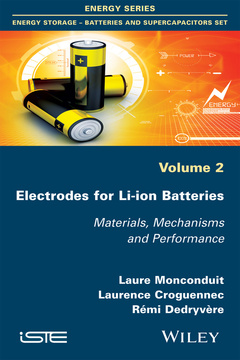Electrodes for Li-ion Batteries Materials, Mechanisms and Performance
Auteurs : Monconduit Laure, Croguennec Laurence, Dedryvère Rémi

The electrochemical energy storage is a means to conserve electrical energy in chemical form. This form of storage benefits from the fact that these two energies share the same vector, the electron. This advantage allows us to limit the losses related to the conversion of energy from one form to another. The RS2E focuses its research on rechargeable electrochemical devices (or electrochemical storage) batteries and supercapacitors.
The materials used in the electrodes are key components of lithium-ion batteries. Their nature depend battery performance in terms of mass and volume capacity, energy density, power, durability, safety, etc. This book deals with current and future positive and negative electrode materials covering aspects related to research new and better materials for future applications (related to renewable energy storage and transportation in particular), bringing light on the mechanisms of operation, aging and failure.
PREFACE ix
INTRODUCTION xi
CHAPTER 1. NEGATIVE ELECTRODES 1
1.1. Preamble 1
1.2. Classic materials: insertion mechanism 3
1.2.1. Graphitic carbon 3
1.2.2. Titanium oxides 7
1.3. Toward other materials and other mechanisms 13
1.3.1. Silicon 14
1.3.2. Other block p elements 19
1.4. Summary on negative electrodes 27
CHAPTER 2. POSITIVE ELECTRODES 29
2.1. Preamble 29
2.2. Layered transition metal oxides as positive electrode materials for Li-ion batteries: from LiCoO2 to Li1+xM1-xO2 30
2.2.1. The layered oxide LiCoO2: the starting point 31
2.2.2. From LiNiO2, initially explored as an alternative to LiCoO2, to the commercialization of LiNi0.80Co0.15Al0.05O2 (NCA) and LiNi1/3Mn1/3Co1/3O2 (NMC) 34
2.2.3. Electrode/electrolyte interfaces and aging phenomena in layered oxides 40
2.2.4. High-capacity Li-rich layered oxides 43
2.3. Alternatives to layered oxides 49
2.3.1. Materials with spinel structure: from LiMn2O4 to LiNi1/2Mn3/2O4 50
2.3.2. The olivine phase LiFePO4: a small revolution 57
CONCLUSION 63
BIBLIOGRAPHY 65
INDEX 81
Laurence Croguennec, Université de Bordeaux, France.
Laure Monconduit, Universite Montpellier 2, France.
Rémi Dedryvère, Université de Pau et des Pays de l'Adour, France.
Date de parution : 06-2015
Ouvrage de 100 p.
15.8x23.4 cm
Thème d’Electrodes for Li-ion Batteries :
Mots-clés :
introduction; ix; insertion; classic; electrodes; negative; electrode; oxides; metal; transition; xo; liion; licoo; materials; positive; batteries; xm; oxide licoo; point; alternative; initially; commercialization; lini; electrolyte



